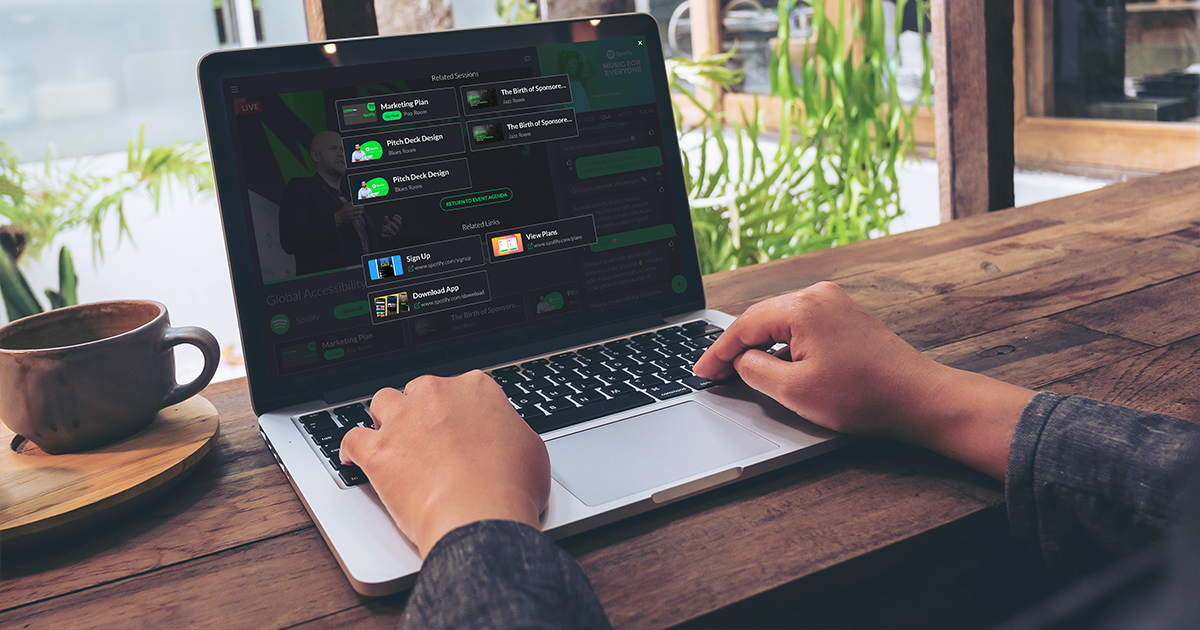From what we’re hearing from the industry, from many of our clients, and from our own sessions, registrations for virtual events are well ahead of expectations. Meanwhile, conversion from registration to attendance is very high as well - perhaps a consequence of lockdown and most of us having a little more time to pause, think and learn, rather than jumping on the hamster wheel and just ‘doing’.
I expect it will drop off as we slowly return to the office environment. While we think there are so many distractions at home, in reality there can be plenty of distractions in the office that may have previously caused higher no-shows for online events.
That means it’s fundamental that event organizers take this opportunity, while they have ‘share of mind’, to deliver compelling sessions that build a loyal attendee-base for future events - be they virtual, in-room, or probably hybrid.
Yet so many of these events are underwhelming at the moment, and I think a big part of that is the strict adherence to the linear, regimented flow of content we’re used to at physical events.
Many virtual events are still going with...
- 9am: Opening Remarks
- 9.30am: Key Speaker
- 10.30: Coffee/Networking
- 11am: Panel Discussion
- Afternoon Breakouts
- Closing Keynote Session
This event structure has become the norm because of the confines of a physical event:
- A start time designed to mirror the working day and allow for travel
- Something important straight away so people don’t drift in late
- Strict coffee slots to avoid people disrupting sessions by wandering out halfway through
- Panels to try to wake people up a bit or try to cram in more speakers/sponsors
- Breakouts with start times all aligned to coordinate the flow of people round a venue
- Someone important at the end to avoid people leaving early
- A full day’s event because that’s how long you’ve got the venue booked for
While we have the chance to run pure virtual events (before hybrid set-ups bring some physical restrictions back), let’s try to rip up that old rulebook.
Without some of the constraints, we can explore alternative event designs:
- Start with some early sessions, perhaps with a geographic focus or presented in Chinese or Japanese (or translated with our Wordly.ai integration) to capture new delegates from those markets, or the tail end of the Australian / New Zealand day?
- Consider multiple half-days spread out over a few weeks, rather than three days in a row, with on-demand replays in between
- Blend a wide range of session formats including breakouts, audience-driven content sessions, informal networking, creative workshops, or leftfield options such as mindfulness workshops or yoga - and do it without regimented ‘stages’ for each format
- Shorten sessions and mix up start times so they don’t all start and end at the same point, allowing users to move between sessions independently, personalising their experience
- Rather than bookending with the best content or popular speakers to stretch out the day, use these as key entry points and look to retain delegate engagement from there by creating non-linear attendee journeys
How Glisser can help
These last two points are something we’ve been thinking about a lot.
As Glisser was first designed to improve audience engagement for physical events, before incorporating hybrid options a few years ago, we’ve largely mimicked the physical event structure. That means we originally created an event structure based around days, ‘rooms’ or ‘stages’, and time-slots for content.
A few months ago we added ‘topics’ which allowed our clients to create ‘always-on’ content that could be consumed by audiences at their leisure, or create breakout spaces or virtual booths for sponsors not defined by a strict timeslot.
Now we’ve released ‘related content signposts’ that are the next important step in enabling improved audience retention, allowing a more lateral and personalised journey through event content.
What are ‘related content signposts’ and what are the benefits?
If you think of a traditional event structure, your delegates arrive on the first day, at roughly the same time, and then select a room/track/stream/stage and consume content, or go to informal areas like lobbies or sponsor areas to network or take a break. Once in a room, they generally stay until the end of a session then decide whether to stay there and watch the next session, go to another room for a different session, go into the informal area, or leave. It’s a pretty structured process based around fixed session start and end times, and a fair amount of politeness about not leaving sessions halfway through.
If they choose to change rooms, your delegates return to a lobby area, maybe consult a map or event app, then find the physical location of their next session. The lobby area is a bit like a ‘home’ screen. Your delegates have to keep returning there to move around, and each time they go there, there is a chance they’ll miss a session or just leave.
The beauty of an online environment is that it doesn’t have to be that linear…
Instead, mid-session delegates should be able to choose to visit a related sponsor, swap to another session that looks more interesting, connect with other delegates, or attend a yoga class. In fact, they should have a simple way to create their own unique journey through your program of activities in the simplest way possible. There is no need to keep returning to the lobby!
What’s more, event organizers should use their own expertise, or event objectives, to help guide this journey. These ‘signposts’ should be as contextual as possible - so a speaker session on Bitcoin, for example, could have signpost links to the virtual booths of Bitcoin-related sponsors. This encourages the delegate to take this as the next step on their personalized journey.
What’s more, over time event organizers can use the data from thousands of virtual delegate journeys to help design their event signposting for future events, combining with other data points for their delegates, and potentially using AI to suggest optimal routes for future attendees.
Think of it like YouTube’s ‘Up Next’ videos, but for your event. Constantly giving your attendee the next place to go at the touch of a button, keeping them engaged with the next session they can drop into, and giving them full control over their journey and the way they use their time.
Google does such a good job with this within their YouTube platform, we all know how we can spend hours watching video after video. Event planners who think like Googlers in content design, have the potential to deliver exactly the same engaging experience that keeps pulling delegates back in for more…








